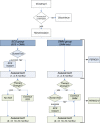Spinal cord stimulation for predominant low back pain in failed back surgery syndrome: study protocol for an international multicenter randomized controlled trial (PROMISE study)
- PMID: 24195916
- PMCID: PMC4226255
- DOI: 10.1186/1745-6215-14-376
Spinal cord stimulation for predominant low back pain in failed back surgery syndrome: study protocol for an international multicenter randomized controlled trial (PROMISE study)
Abstract
Background: Although results of case series support the use of spinal cord stimulation in failed back surgery syndrome patients with predominant low back pain, no confirmatory randomized controlled trial has been undertaken in this patient group to date. PROMISE is a multicenter, prospective, randomized, open-label, parallel-group study designed to compare the clinical effectiveness of spinal cord stimulation plus optimal medical management with optimal medical management alone in patients with failed back surgery syndrome and predominant low back pain.
Method/design: Patients will be recruited in approximately 30 centers across Canada, Europe, and the United States. Eligible patients with low back pain exceeding leg pain and an average Numeric Pain Rating Scale score ≥5 for low back pain will be randomized 1:1 to spinal cord stimulation plus optimal medical management or to optimal medical management alone. The investigators will tailor individual optimal medical management treatment plans to their patients. Excluded from study treatments are intrathecal drug delivery, peripheral nerve stimulation, back surgery related to the original back pain complaint, and experimental therapies. Patients randomized to the spinal cord stimulation group will undergo trial stimulation, and if they achieve adequate low back pain relief a neurostimulation system using the Specify® 5-6-5 multi-column lead (Medtronic Inc., Minneapolis, MN, USA) will be implanted to capture low back pain preferentially in these patients. Outcome assessment will occur at baseline (pre-randomization) and at 1, 3, 6, 9, 12, 18, and 24 months post randomization. After the 6-month visit, patients can change treatment to that received by the other randomized group. The primary outcome is the proportion of patients with ≥50% reduction in low back pain at the 6-month visit. Additional outcomes include changes in low back and leg pain, functional disability, health-related quality of life, return to work, healthcare utilization including medication usage, and patient satisfaction. Data on adverse events will be collected. The primary analysis will follow the intention-to-treat principle. Healthcare use data will be used to assess costs and long-term cost-effectiveness.
Discussion: Recruitment began in January 2013 and will continue until 2016.
Trial registration: Clinicaltrials.gov: NCT01697358 (http://www.clinicaltrials.gov).
Figures
References
-
- Turk DC, Okifuji A. In: Bonica’s Management of Pain. 3. Loeser JD, editor. Philadelphia: Lippincott Williams & Wilkins; 2001. Pain terms and taxonomies of pain; pp. 17–25.
Publication types
MeSH terms
Substances
Associated data
LinkOut - more resources
Full Text Sources
Other Literature Sources
Medical


